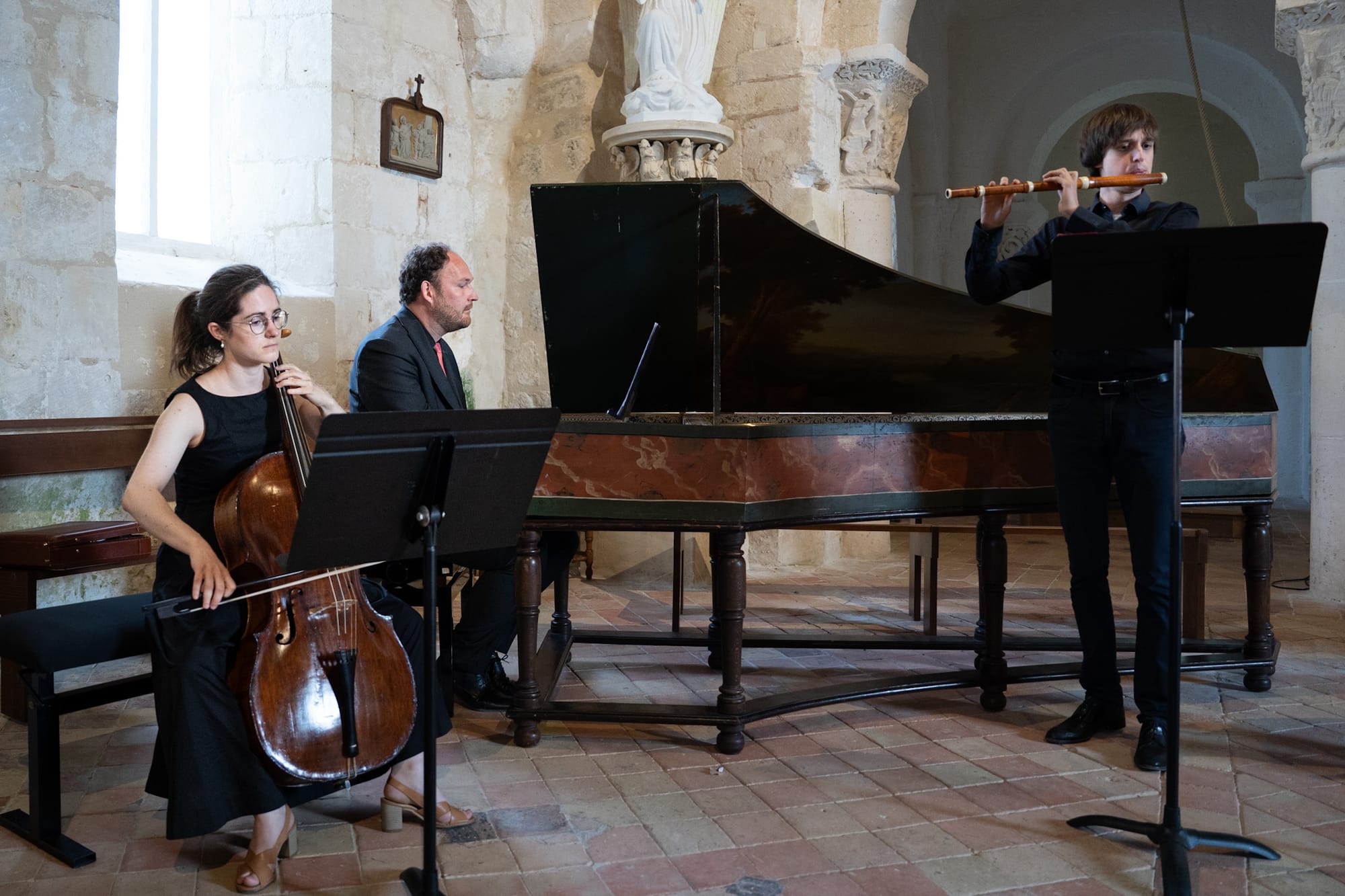L'Itinéraire baroque (3): Dutch Baroque plays Dutch Baroque
A fascinating programme!

Itinéraire baroque en Périgord 2025: L'Itinéraire: Dutch Baroque plays Dutch Baroque Dutch Baroque (Ivan Iliev, violin; Beniamino Paganini, transverse flute; Anne-Linde Visser, cello; Gerard de Wit, organ/harpsichord/director). Église Saint Pierre d’Edon, France, 02.08.2025
Hellendaal Sonata in D minor for violin and basso continuo, Op. 4/3
Ruloffs Sonata in G for violin, cello and harpsichord, Op. 1/1
Focking Sonata in D for transverse flute and continuo, Op. 1/5
De Fesch Trio Sonata in G minor, Op. 7/4
Housed in the diocese of Péigueux and dating from the 11th and 12th centuries (with pointed arches on the south side from the 15th to early-16th century), the Église Saint Pierre in Edon is the perfect venue for chamber music of this ilk. readers might remember Beniamino Paganini from Musica Gloria, both at last year's Iinéraire (review) and, later in November, in Edinburgh.
Curiously, and as a point of interest, Mike Fentross, who was theorbist in Orpheus Britannicus, has recorded a disc of Peter Hellendaal with La Sfera Armoniosa; see Classical Explorer's post here. Small world.
Even smaller when one realises Ton Koopman has recorded the Hellendaal Sonata in D, Op. 4/3 heard here (with Monica Huggett, violin, and Richte van der Meer, cello). Hellendaal was born in Rotterdam, but made his career in England. This Sonata in D minor is beautiful, the opening Affetuoso glowing here because of Ivan Iliev's warm-toned violin. The performance was stately and dignified; and inspired. A short movement (around 90 seconds), it made a huge mark; a jaunty Allegro followed (it is testing up in the violin's upper registration, and that aspect was audible), But the revelation is the finale, a 'Pastorale' with drones and stopping. Perhaps this was just a touch under-tempo (Koopman's recording nails it!):
If Hellendaal is obscure, we delve even deeper with Bartholomeus Ruloffs (1741-1801), who we know was active in Amstedam. There are various versions available of his first name, two of which were used in the programme booklet across two pages (‘Bartholomeus’ and ‘Bernardos’). A recording of the Sonata Op. 1/1, again with Richte van der Meer and Huggett, but now also with Tini Mathot on harpsichord on Intermusic, opts for ‘Batholomew’. He is best known (if at all) for his music to the Singspiel (’zangspel’) Zemire en Azor, which was a real stepping stone towards opera in Dutch. My own notes during the concert recorded Ruloff's Sonata in G-Minor as a ‘fairly interesing piece,’ jaunty in the opening Allegro. Mathot et al persuade me it is more, which is telling. The central Andantino is of minuet demeanour, but is much darker, and de Wit’s harpsichord came to the fore here. It felt more like a keyboard sonata with violin (no bad thing!) before the final Vivace cleared any clouds (a nice and feisty end, too!): if de Wit had a metaphorical day in the sun in the second movement, the sun shone properly in the finale. There are some lovely harmonic sequences that last movement, too.
The memorably-named Hendrik Focking (1747-96) was born in Danzig. He was blind, and became the carillon player in the Oude Kerk and Munt Tower in Amsterdam. Not much survives by him, but there is a set of six violin sonatas, of which this is one, an Allegro, Largo and Andante con 4 variazioni. Thematically not a million miles from the Ruloffs, the first movement takes the material in a different, very fresh direction, contrasting that freshness with a slower descending line that was perfectly delivered here by Paganini and friends (Wilbert Hazelet on flute with van der Meer and Koopman in their recording rather milk it). The central Largo was given all the space it needed by Paganini, Visser and de Wit while the final set of variations was fascinating in its flute ornamentation. Parts of this sonata felt more Rococo than Baroque, interestingly.
Talking of progressions, we can safely move onto a Trio Sonata for transverse flute, violin and basso continuo by Willem de Fesch (1687-1761). While not, under any circumstances, obviously, to be confused with Fasch, it is interesting that an old Crystal LP (big black circular things) released in around 1980 presented a development of the Trio Sonata via works by Bach, Fasch, de Fesch, and onto Karl Stamitz: apart from the semi-homonymic non-relationship (!), that was an interesting progression which ‘places’ our Willem. And at last, here in France, in the first movement, all members of Dutch Baroque played together, a very lovely Largo, blessed with some fantastic, and fantastical, flourishes for flute and violin towards the end (again, one can hear Koopman and his pals from the Amsterdam Baroque Orchestra on disc, but Dutch Baroque were preferable, fresher). Iliev and Paganini delivered the rigorous counterpoint that opens the central Alla breve with all the firm articulation of a Bach fugue (this movement also served as encore); it is a fascinating, beautifully written (and, here, executed) piece. Finally, a Presto, perfectly paced, identifiably a Presto without undue blurring. This is a cat-and-mouse chase between flute and violin; what a fine way to close!
A fascinating programme.
Here's the first movement, via Koopman:
